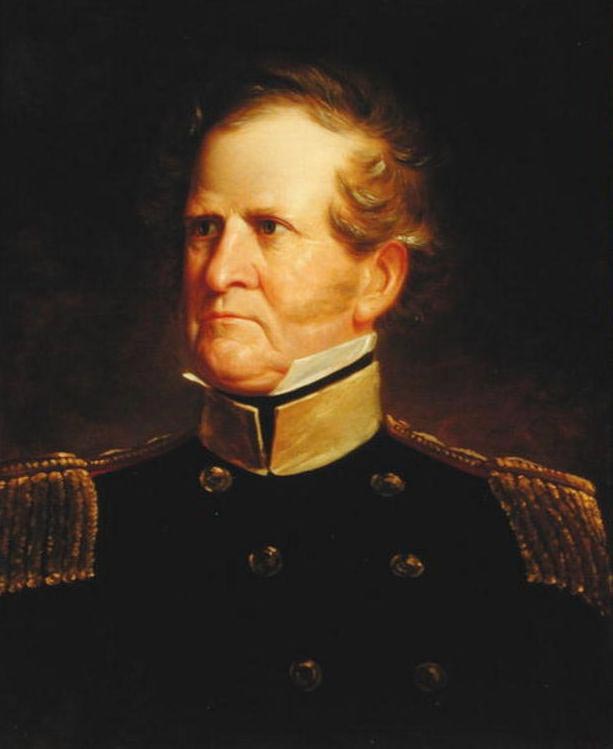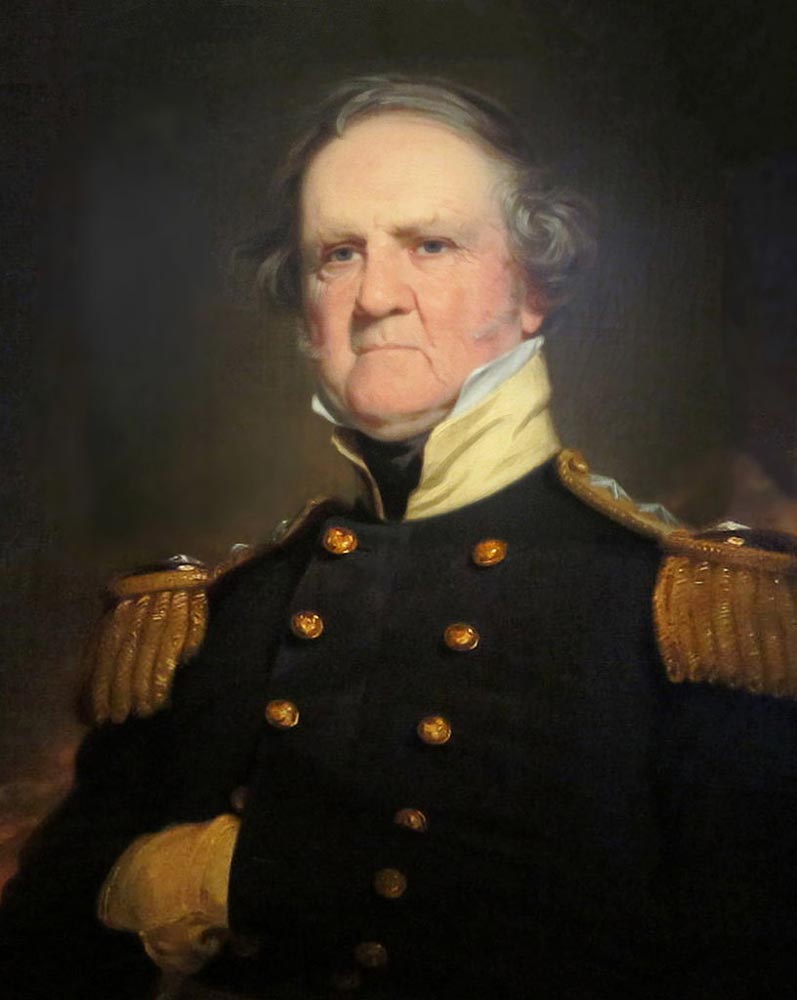Winfield Scott (1786-1866) was a general in the United States Army, known as its “Grand Old Man” because of the length of his service. He was an active general for longer than anyone else in American history. He gained a reputation as a superb commander. His service record stretched from the War of 1812 to the Civil War, in which he thought up what would become known as the Anaconda Plan.
In 1852, he made an unsuccessful bid to become President, but his political career was of little significance when compared to his military achievements.
Early Life
Scott was born in Virginia, near the town of Petersburg, and was educated at the College of William and Mary. However, he did not graduate from the college, and he then spent a few years meandering around the borders of other professions.
After a rather short-lived attempt at training to become a lawyer, Scott dropped his studies in law in 1808 and signed up for the U.S. Army, in which role he was to spend the great majority of the remainder of his life.
This was in fact not quite his first military experience, since the previous year, Scott had served for a few months as a corporal in the cavalry of the Virginia militia.
The War of 1812 saw Scott’s first significant experience of front-line service when, as a young lieutenant colonel, he served in Canada. At Queenston Heights, he was taken by British soldiers and was held by the British for about a year. After this time, an exchange of prisoners between the two sides resulted in Scott’s release.
By March 1814, was promoted to brigadier general, and in this position he was instrumental in the conduct of the American action at the Battle of Lundy’s Lane. Badly wounded in the engagement, Scott spent his time after the war touring Europe in order to improve his knowledge of military tactics.
Becoming a War Hero
 By 1832, having fully recovered from his injuries, Scott was in action in short campaign against the so-called British Band, the Black Hawk War. Later on, President Andrew Jackson decided to send him to South Carolina, in order that he might help to soothe tensions among that state’s inhabitants over the then-raging nullification crisis. Six years later, he played a major part in forcing the Cherokee Indians, who had been living in Georgia, to Western reservations along the infamous Trail of Tears.
By 1832, having fully recovered from his injuries, Scott was in action in short campaign against the so-called British Band, the Black Hawk War. Later on, President Andrew Jackson decided to send him to South Carolina, in order that he might help to soothe tensions among that state’s inhabitants over the then-raging nullification crisis. Six years later, he played a major part in forcing the Cherokee Indians, who had been living in Georgia, to Western reservations along the infamous Trail of Tears.
In 1839, Scott assisted in bringing about a truce in the Aroostook War, and two years later, he was made the U.S. Army’s general-in-chief. He was to hold that job for a full two decades, a feat described then and now as an extraordinary achievement.
At the outbreak of the Mexican-American War, which was fought in the late 1840s, Scott was placed in command of the entirety of the American forces. He took personal control of the troops engaged in the campaign in the south, with his right hand man, Zachary Taylor, commanding the troops further north.
Scott commanded the forces that led the successful assault on Vera Cruz, capturing it from the Mexicans in the early months of 1847. Scott’s army was assisted by significant naval forces. Once this had been achieved, he took his men west on an extended march toward Mexico City. On the way, he took part in a number of major battles, including Contreras, Cerro Gordo, Chapultepec and Churubusco. By September 1847, Scott’s forces had succeeded in capturing the national palace of Mexico.
 By this time, Scott had come to be regarded as a war hero throughout the nation and, since he had strong Whig sympathies, Washington’s Democrats began to look for ways in which they might manage to undermine him. For this reason, President James K. Polk recalled him to the capital in 1848 in order that Scott might be forced to appear before a court of inquiry.
By this time, Scott had come to be regarded as a war hero throughout the nation and, since he had strong Whig sympathies, Washington’s Democrats began to look for ways in which they might manage to undermine him. For this reason, President James K. Polk recalled him to the capital in 1848 in order that Scott might be forced to appear before a court of inquiry.
In the event, none of the charges were actually pressed. Scott continued his work for the Whigs and was adopted by that party as its candidate in the Presidential Election held in 1852. Unfortunately for his party, Scott was an ineffective campaigner and the Whigs were crushed: Franklin Pierce, the Democratic candidate, won 254 electoral college votes to Scott’s mere 42, while the Whigs carried only four of the nation’s 31 states.
Later Career and Civil War
 Returning to his more impressive Army career, Scott was sent to the Islands of San Juan in Washington in 1859, to defend territory which had been claimed by Britain. By now the threat of secession by certain Southern states was becoming real. Scott, although a Southerner, was strongly opposed to the breaking up of the United States.
Returning to his more impressive Army career, Scott was sent to the Islands of San Juan in Washington in 1859, to defend territory which had been claimed by Britain. By now the threat of secession by certain Southern states was becoming real. Scott, although a Southerner, was strongly opposed to the breaking up of the United States.
Scott was still general-in-chief of the U.S. Army when war finally came in 1861, but by this time he was not the fit and able commander of his younger days. He was overweight, and his health was failing. Scott was an old man in his mid-seventies.
Mindful of his deteriorating condition, Scott suggested to President Abraham Lincoln that overall command should be transferred to Robert E. Lee, but the latter refused to accept Lincoln’s offer.
Scott devised the strategy that was later to be called the “Anaconda Plan,” an encircling blockade which would slowly starve the South of men and supplies. In the early stages of the war, this was a highly unpopular view: both camps believed that the conflict would be short and sharp. Only at the First Battle of Bull Run, in which the Union forces were crushed, did Scott’s plan begin to be taken more seriously.
President Lincoln allowed Scott to resign from his post in November 1861. Somewhat reinvigorated by the lifting of the burden of command, he survived for another five years, allowing him to see the war come to a close – and to see something close to the Anaconda Plan he had first suggested be implemented with some success. He spent his last years traveling across Europe and writing his memoirs. Despite his liking for military finery, which brought him the nickname of “Old Fuss and Feathers”, Scott’s legacy was secure: he is often ranked with Lee as one of the finest military commanders since George Washington.
